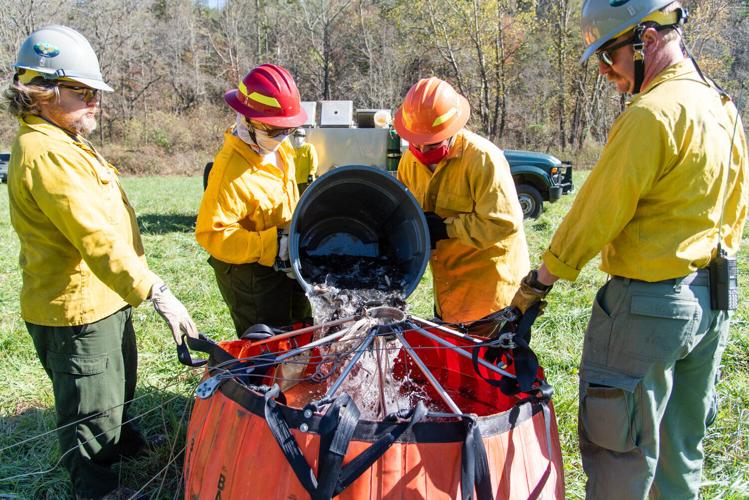WALHALLA — Every year, the S.C. Department of Natural Resources stocks a remote Upstate river with trout: rainbow, brown and eastern brook.
But the Chattooga River, which comprises more than 20 miles of the northernmost border between South Carolina and Georgia, isn't an easy place to reach. It was declared a "wild and scenic" river by the U.S. Forest Service decades ago and after that happened, several accesses to the waterway via old logging roads were closed.
That's where helicopters come in.

The bottom of the "Bambi bucket" opens to drop a load of trout into the Chattooga River. aylor Main/SCDNR/Provided
Every year around this time, wildlife officials with the help of the Forest Service uses a chopper that's typically a firefighting tool to get there.
Instead of dropping water to squelch a blaze, the craft lifts an orange basket filled with fish into the harder-to-reach stretches of the stream. The bottom of the "Bambi basket" is synched, and the pilot of the helicopter can release the line that keeps it closed so that fish and water spill into the stream below.
"It's an amazing design with all the moving parts that it works as well as it does," said Dan Rankin, DNR's lead trout biologist.
One load in the basket might carry 300 to 400 larger fish, Rankin said. Loads of smaller fingerlings that are not yet adults might number as many as 1,000 per drop.
The trip requires a deft touch, as the pilot has to carefully maneuver the basket hanging several feet below the helicopter, over pines, hemlocks and oaks and finally atop the Chattooga. The annual drops support popular fly-fishing spots at Burrells Ford Campground and near Highway 28. Anglers who pick other spots on the river largely have to hike there.
It's not uncommon to use creative means to get fish past obstructions. A "salmon cannon" that became an internet sensation in 2019 is also crucial to allowing those fish to spawn when dams stand in the way, The Seattle Times reported. In South Carolina, there's a fish elevator to move some species past Santee Cooper's hydroelectric dams.

The orange "Bambi bucket" hangs several feet below a helicopter, full of trout bound for the Chattooga River. The helicopter pilot has to carefully maneuver over heavily forested areas to reach the waterway. Taylor Main/SCDNR/Provided
In this case, there isn't a blockage to the fish — there simply aren't enough being spawned in some parts of the river to support a fishery, Rankin said.
The agency has plenty of experience in hatching the fish in its nearby Walhalla facility, which has been growing trout since the 1930s. But, like farming, "you have good years and bad years," Rankin said.
A future threat to all trout species is the potential for the coldwater streams they frequent to get warmer. Rankin called rising temperatures due to climate change "a big concern" for trout, which do best in waters that are around 70 degrees or colder.

Trout grown at a hatchery in Walhalla, S.C. are bound for the Chatooga River. Taylor Main/SCDNR/Provided
While research is still being conducted on threats to the fish, one U.S. Geological Service study in 2016 found that in warmer waters, brown trout, which are not native to the eastern United States, outcompeted brook trout.
For now, DNR will continue its stocking program, which is also supported by the Georgia Department of Natural Resources and nonprofit Trout Unlimited. Rankin, himself an angler, said the program supports a fishery in one of the most pristine areas of the state.
The Chattooga River is "just a special place to be," Rankin said.















